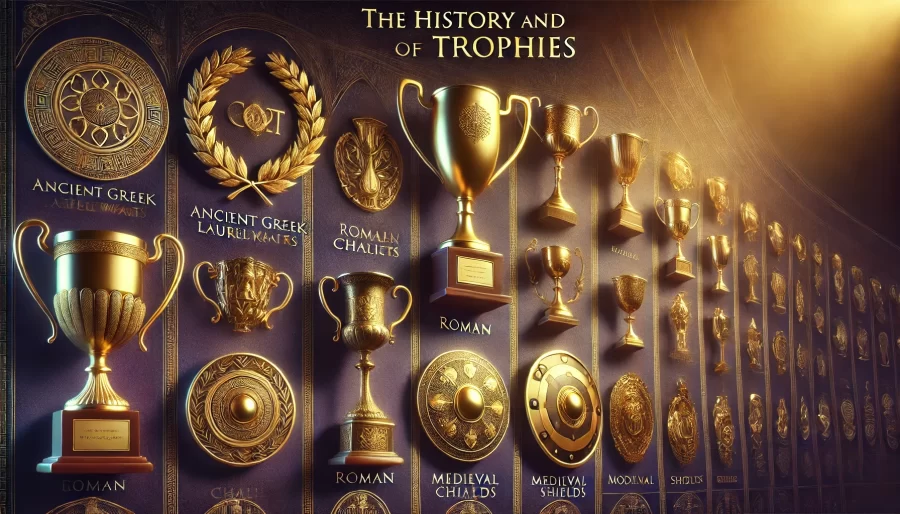Trophies have long been a symbol of victory, achievement, and recognition. From ancient times to the present day, they have evolved in form, meaning, and significance, reflecting the values and cultures of the societies that cherished them. This blog explores the fascinating history and evolution of trophies, tracing their journey from primitive symbols of success to the sophisticated and diverse awards we know today.
Ancient Beginnings: Trophies as Symbols of Conquest
The concept of a trophy can be traced back to ancient civilizations, where trophies were often literal spoils of war. The word “trophy” itself is derived from the Greek word “tropaion,” which referred to a monument erected on the battlefield to celebrate a military victory. These early trophies often included the weapons, armor, and other possessions of defeated enemies, displayed prominently as a testament to the victor’s prowess and dominance.
In ancient Rome, similar practices were followed, with victorious generals bringing back spoils of war to be displayed in triumphal processions. These trophies were not just symbols of individual achievement but also served to glorify the state and its military might.
The Middle Ages: Trophies in Chivalric Traditions
During the Middle Ages, the tradition of awarding trophies began to extend beyond the battlefield to other forms of competition, particularly in the context of chivalric tournaments. Knights who excelled in jousts and other martial contests were often awarded prizes that served as symbols of their bravery and skill. These early trophies were often elaborate, featuring ornate designs and valuable materials, reflecting the prestige of the event and the status of the recipient.
In addition to physical trophies, heraldic symbols and coats of arms also served as a form of recognition and reward, marking a knight’s achievements and lineage.
The Renaissance and Beyond: Trophies in Sporting Events
As society evolved, so did the nature of trophies. The Renaissance period saw a renewed interest in sports and physical competitions, and with this came the creation of more standardized trophies for events like horse racing, archery, and fencing. These trophies began to take on more recognizable forms, often featuring figures or motifs related to the sport in question.
By the 18th and 19th centuries, trophies had become an integral part of organized sports. Silver cups, medals, and other awards were commonly given to winners of various competitions, from local contests to international events. The design of these trophies often reflected the artistic trends of the time, with intricate engravings and detailed craftsmanship.
The Modern Era: The Rise of Customization and Diversity
In the 20th century, the world of trophies underwent significant changes, driven by advances in technology and the growing diversity of competitions and events. No longer limited to sports, trophies began to be awarded in a wide range of fields, including academics, business, and the arts. This period also saw the rise of mass production, allowing for a greater variety of trophy designs and making awards more accessible to people of all walks of life.
One of the most significant developments in the modern era has been the trend toward customization. Today, trophies can be tailored to suit the specific achievement being recognized, with options for personalized engravings, unique designs, and even custom materials. This has made trophies more meaningful, as they can be crafted to reflect the individuality of the recipient and the significance of the accomplishment.
The Future of Trophies: Innovation and Sustainability
As we look to the future, the evolution of trophies continues, driven by new technologies and changing societal values. Digital trophies, awarded in the form of virtual badges and achievements, are becoming increasingly common in online gaming and e-sports. These digital awards reflect the changing nature of competition in the modern world, where achievements are often virtual rather than physical.
At the same time, there is a growing emphasis on sustainability in trophy design. Eco-friendly materials, such as recycled metals and biodegradable plastics, are being used to create trophies that are not only beautiful but also environmentally responsible. This reflects a broader trend in society toward sustainability and conscious consumption, ensuring that trophies remain relevant and respected in the years to come.
From ancient battlefields to modern boardrooms, trophies have played a significant role in human history, evolving in form and function to reflect the changing values of society. Today, they continue to serve as powerful symbols of achievement and recognition, honoring the hard work, dedication, and success of individuals and teams across the globe. As we continue to innovate and adapt, the tradition of awarding trophies will undoubtedly endure, celebrating the triumphs of the human spirit for generations to come.





Leave a Reply
Your email is safe with us.